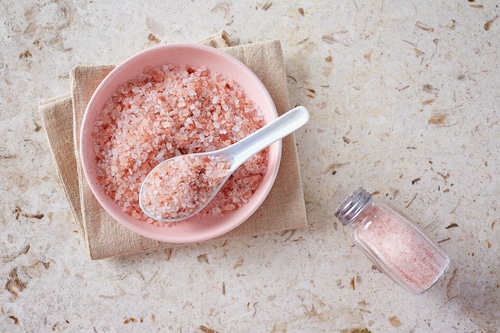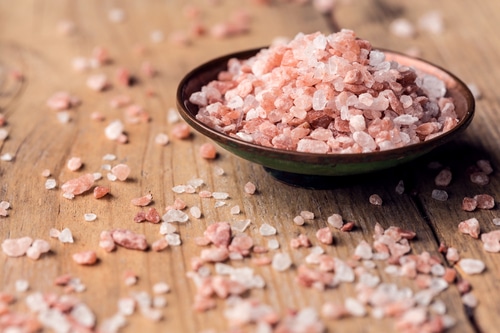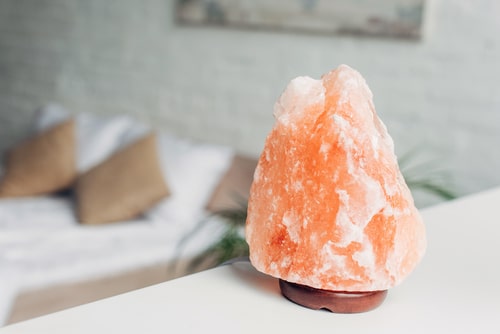Himalayan salt has been a buzzword in food circles of late, but what is all the fuss about? What’s so special about cooking with and using salt from this part of the world? Or, is it merely just a fad and something trendy to do? Let’s learn more about Himalayan salt, why it’s so popular in the culinary world and what the benefits are of blending this unique salt with your favourite food. Then you can make up your own mind if Himalayan salt is the right choice for you.

What Is Himalayan Salt Exactly?
It’s a form of rock salt rather than sea salt. Forms of sea salt are most commonly used in cooking and to season food. While sea salt is predominantly pure white, Himalayan salt is actually mostly pink and white in colour, due to the presence of certain minerals contained within the salt.
Mined from the Salt Range Mountains just south of the Himalayan Mountains in Northern Pakistan, the geological makeup of Himalayan salt is crystalline halite and potash salts. The majority of Himalayan salt is made up of sodium chloride (or traditional table salt) with some trace elements of minerals.
The individual crystals can vary in colour from clear, to white, to pink to a reddish or orange hue. Some crystals are a mixture of all of these colours.

Himalayan Salt and Its Origins
Himalayan salt is also known as “Halite”. Like sea salt, it’s mostly made up of sodium and is an edible crystal. However, it’s far more unique in its geological makeup compared to sea salt, wherein the crystals of Himalayan salt tend to form near-perfect patterns. The crystals themselves can range in colour from white to pink, orange and even really dark reds and purples. Some crystals can be almost black in colour. This varied colour spectrum is due to the salt containing an array of trace elements and minerals, which are covered in more detail in the next section.
The way Himalayan crystal salt was formed was the result of a prehistoric sea being trapped in the Himalayan Mountain ranges. It’s estimated this sea formed some 200 million years ago. Himalayan salt has been revered for centuries for having certain nutritional and healing properties, whether it is consumed with food or used externally.
The Discovery Of Himalayan Salt
While desperately in need of both water and food, this need led to the discovery of Himalayan salt by Alexander the Great, along with his soldiers. In fact, it was the fatigued and hungry horses that ultimately led Alexander and his army to the Himalayan mineral salt deposits as they staggered through the region. Discovering great slabs of mineral-laden salt, the soldiers chipped off massive chunks of the stuff to carry with them for sustenance.
Jalaluddin Muhammad Akbar of India, a Mughal Emperor, later decided to start mining the Himalayan salt for both locals and for trading with international merchants. It wasn’t until the late 1820s that salt mines became fully established. These days, along with providing the world with pink Himalayan salt, the region has also become somewhat of a tourist attraction, drawing some 300,000 visitors to the northern reaches of Pakistan each year. One reason for the influx of tourists is the fact that mini replicas of famous structures have been carved into the Himalayan salt, such as the Eiffel Tower, the Great Wall of China and even a small Mosque.
What Can Himalayan Salt Be Used For?
The main use of Himalayan salt is to flavour and season food, just as is done with everyday table salt. Sometimes, the salt is blended into the food, while other times it’s used as a decorative garnish to add a touch of something interesting to the presentation of a meal, particularly when used commercially.
When the salt is mined, it comes in the form of slabs to be broken down into individual crystals. Some of these slabs are preserved just the way they are and are used as serving platters. Tequila shot glasses have also been crafted from Himalayan salt. When used to serve tequila, some of the natural salt flavours is imparted to the liquor for an enhanced flavour experience.
Another popular use of Himalayan salt is in decorative lamps, due the to beautiful colours and translucency of the crystals. Known simply as “salt lamps”, these lamps radiate the natural hues of the salt crystals, making for stunning results.

Are There Any Distinct Health Benefits?
Himalayan salt does have some health benefits, most noticeably those that are also inherent in sea salt. The human body requires a certain amount of sodium to be healthy and to function properly and this sodium can be obtained through the consumption of Himalayan salt.
Aside from the heavy presence of sodium chloride in Himalayan salt, there are other trace elements of minerals in safe amounts that include:
- Zinc
- Iron
- Calcium
- Sulphate
- Chromium
- Magnesium
These trace elements can vary from slab to slab and crystal to crystal.
One thing that is lacking from Himalayan salt that you will find in most table salt is the presence of iodine. In many countries, table salt producers add iodine to help prevent cases of iodine deficiency, which was once a widespread problem in many locations, including Australia.
Himalayan Salt – What’s So Great About It?
One of the main reasons Himalayan salt is healthy for human consumption is, the way, it was formed. For more than 200 million years the salt crystals have been forming and maturing in the foothills of the Himalayas under immense tectonic pressure. The environment is also pristine and free of modern pollutants and impurities. It’s also said that the unique cellular structure of the Himalayan salt crystals allows the salt to store positive vibrational healing energy.
Existing in colloidal form, Himalayan salt crystals are tiny enough for the human body to readily absorb. There are also more than 80 minerals and trace elements present in Himalayan salt. Many of these minerals are essential for human health.
Let’s now list some key health benefits of switching to Himalayan salt:
- Improved pH balance in the brain and the body, including the skin
- Himalayan salt propagates hydroelectric energy in the body’s cells
- Water levels within the body or more evenly controlled and regulated
- The salt improves blood sugar health
- Vascular health is assisted
- It’s good for the respiratory system
- Himalayan salt can reduce the signs of ageing
- Reduced muscle cramps
- Improved bone and structural strength
- Himalayan salt helps to improve digestion and maintain the health of the intestinal tract
- Improved libido
- Can help prevent cellulite
- Improved sinus health and lowering of the symptoms of sinus problems
- Regulates blood pressure in combination with water
- Helps with insomnia and improves sleep patterns
- Reduces your chances of developing kidney stones or gall stones
- Reduce the likelihood of developing gout, arthritis and rheumatism
Salt in itself is not unhealthy, but the way in which table salt has been processed has rendered it so. We consume way too much salty and processed food in modern society, so adding all-natural and mineral-rich Himalayan salt to the diet to replace table salt is a positive move.
The Natural Shades and Colours Of Himalayan Mineral Salt
Himalayan salt crystals are naturally beautiful due to their many and varied colours created by minerals within the salt. Some of the more common colours are pure white, various shades of pink, orange, and even deep reds are present. Some crystals contain a combination of all of these hues. In fact, Himalayan salt crystals almost look as beautiful as gemstones.

Along with the 80+ minerals in the salt, the infusion of iron also adds significantly to the colour. The more iron the crystals contain, the more pink, orange or red the crystals will appear. Like with all crystals, if iron is present it will alter the colour of the crystal and it’s the same for Himalayan salt. As an example, amethyst becomes citrine over time with the infusion of iron under heat and pressure.
WHITE Himalayan Salt – Himalayan salt that is pure white is most commonly found in the outer regions of the salt mines. The reason it’s white is due to its low iron content. Because white Himalayan salt is nowhere near as common as the coloured varieties, the sale price is generally higher. It’s said that salt lamps made from white Himalayan salt contain healing properties. When the salt crystals are heated, they release negative ions which help purify the air.
PINK Himalayan Salt – This is the most common form and colour of Himalayan salt and one of the most popular for both cooking and beauty products. Pink Himalayan salt will also have flecks of both white and red present in the crystals.
RED Himalayan Salt – The reason some Himalayan salt is orange or dark red is due to a higher content of iron in the crystals. These colours are stunning for salt lamps.
BLACK Himalayan Salt – This salt is not actually black but more of a reddish-grey hue. Black Himalayan salt contains more sulphur and has a stronger taste. When consumed, the taste buds enjoy a quick hit of flavour, followed by a strong mineral taste. It’s a popular form of salt most commonly used in genuine Indian cooking.
No matter what colour the Himalayan salt crystals are, all contain vital minerals and all are good for the health. Also, when it comes to salt lamps, regardless of the colour of the lamp, Himalayan salt when heated will release negative ions to combat pollutants in the air. Darker lamps tend to be more popular because the colour has a more calming effect.
Regarding Himalayan salt consumption, the best is a balance of pink, white and red crystals. Darker crystals contain more iron and you won’t want to overdo your iron intake. A good and healthy balance is always the best.
Does Himalayan Salt Really Taste Better Than Ordinary Salt?
The answer to this question is really up to the individual. Some may prefer the taste of regular table salt, while others sense a hint of new flavours and textures in Himalayan salt. To state that one salt tastes better than the other is purely open to conjecture and personal preference. Some people claim that Himalayan salt tastes exactly the same as sea salt.
You will have to experiment and do a taste test for yourself and make your own determination.
Is Himalayan Salt Expensive?
Because it’s considered exotic and a lot of money has been injected to market Himalayan salt, consumers can expect to pay up to 20 times what they would normally pay for ordinary table salt in some instances, depending on where you live. Prices will vary from country to country and retailer to retailer but at the end of the day, the price tag will invariably be higher than regular salt.
In Australia, prices vary considerably across retailers, with some selling it for as low as 8 cents per 10 grams, while others are as high as 63 cents per 10 grams. Regular sea salt, on average, costs around 7 cents per 10 grams in Australia.
The Takeaway
So, now you know more about Himalayan salt. While there are no proven added health benefits to eating it, it does look pretty on the plate, is trendy and can a talking point at your next dinner party. It’s always fun to experiment and try something different, so next time you’re cooking, try using some Himalayan salt in your meal as a colourful garnish. It’s bound to be a hit.
Sources:
https://en.wikipedia.org/wiki/Himalayan_salt
https://www.webmd.com/diet/himalayan-salt-good-for-you#:~:text=Magnesium-,Potential%20Health%20Benefits%20of%20Himalayan%20Salt,you%20achieve%20healthy%20sodium%20levels.
https://www.choice.com.au/food-and-drink/groceries/herbs-and-spices/articles/accessible-text-files/salt-prices-compared




